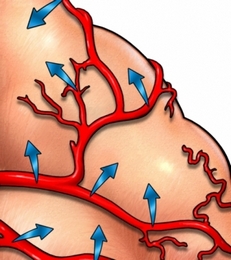Computed tomography angiography – CT angiography
Description of the computer tomographic angiography
Computed tomography angiography (CTA) It is a specialized x-ray, that examines blood flow in arteries, when they filled with contrast medium (substance, that allows you to see the blood vessels on x-ray). CT scan (CT) It uses a sophisticated machine, directing X-rays at different angles, performing a detailed two-dimensional images, which may be combined with a three-dimensional computer image.
ACT can be used to view blood vessels throughout the body. In most cases studied the following organs:
- Brain;
- Heart;
- Lungs;
- Kidneys;
- The legs or arms.

Reasons for computer tomographic angiography
This analysis is used, to help the doctor to identify patients, restricted, increased, and blocked blood vessels and locate, where can meet internal bleeding.
Some specific applications include:
- Discovery atherosclerosis (narrowing of the arteries) or Aneurysm (protrusion portion of a blood vessel);
- Study pulmonary artery, to find the blockage of blood vessels by blood clots or detect foreign matter;
- Evaluation of renal artery disease.
Possible complications of computed tomography angiography
Possible complications of this test include:
- Allergic reactions to the contrast agent;
- Bleeding;
- Renal.
There are certain factors, which may cause the risk of complications during this test:
- Allergy, especially in the X-ray dye, iodine, medicines, or certain foods, including molluscs;
- Kidney disease or diabetes may increase the risk of decreased kidney function from the x-ray dye;
- Coagulation failure.
How is computed tomographic angiography?
Preparation for the procedure
- Before the test,, doctor, probably, makes the following:
- Studying the history of the disease;
- Make a list of the medication;
- Determine the presence of allergy;
- Ask about the availability of pregnancy or trying to get pregnant;
- A few days before testing, Follow your doctor's instructions in the, how to take medicines and restrict the diet;
- In the medical facility:
- The doctor will explain the test procedure and answer your questions;
- You must take off your clothes and wear a hospital;
- We need to remove all metal objects (eg, jewelry, Hearing Aids, prostheses), which may interfere with the passage of X-rays.
Description of the computer tomographic angiography
In the vein needle is inserted which will be supplied by the contrast agent, The patient will lie on a special table. They can be used in pillows and belts, to fix the desired part of the body in a certain position.
Body part, which will be studied, placed under the X-ray machine. Through an IV administered a small amount of contrast agent , to check, how long it takes, that it reached the area, which will be explored. Further, a contrast agent is injected into the bloodstream completely. Then X-rays are performed.
During the execution of the photos need to stand still. Tomography technologist may ask you to hold your breath for 10-25 seconds, to ensure, that the picture will not be blurry. To perform all the necessary shots take a few seconds.
After the computerized tomographic angiography
The images are checked. If necessary, some of them are repeated.
After the procedure, be sure to follow your doctor's instructions. Within a few hours after the procedure, you should drink more fluids, to cleanse the body of contrast agent.
How long does it take for a computer tomografičeskaâ angiography?
20-60 minutes.
Will it hurt?
Although the procedure is not painful, You may feel a burning sensation, when injected contrast agent.
The results of the computer tomographic angiography
Pictures will be sent to the radiologist, which examines them. Your doctor will receive the results and the results can prescribe treatment.
Communication with the doctor after a CT scan
After the test, you need to see a doctor, If the following symptoms:
- Signs of an allergic reaction, including fever, rash and itching;
- Swollen or itchy eyes;
- Shortness of breath or tightness in the throat;
- Nausea.
